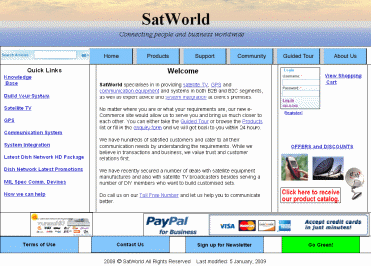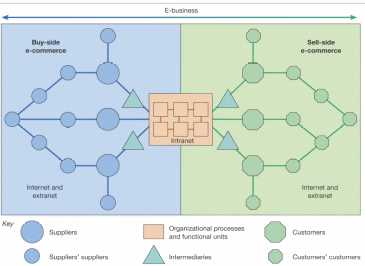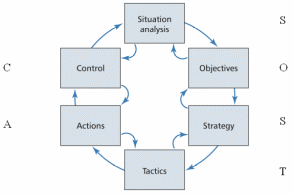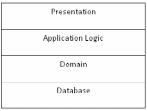Introduction
e-Commerce is seen as one of the key growth areas and business enablers for not only the new age business but also ‘brick and mortar’ companies. By having a viable e-Commerce website and strategy, organisations are able to reach out to thousands of potential customers, spread information easily, help customers to resolve their problems, find out potential clients and also most important, it allows business to be transacted. The paper provides recommendations and a plan for SatWorld to switch to e-Commerce and to help them to move to the e-Commerce platform.
Strategy for Internet marketing and promotion of SatWorld portal
E-Commerce is defined as “the sharing of business information, maintaining business relationships and conducting business transactions by means of telecommunications networks“. E-Business is defined as “the transformation of key business processes through the use of Internet technologies“. eCommerce has the potential to help small companies to look at the world as a market, way beyond the occasional walk in customer or the weekly village sales that would be restricted to mostly locals (Deitel, 2007). There are many challenges in setting up an eCommerce site and while part of the challenges is to adopt the right mix of affordable technology, accessibility and security, success would depend on the manner in which a business brands itself and the business model used along with its product offerings that it wants to transact (Jupiter, 2008).
Proposed Interface
Shown below is the proposed user interface for SatWorld customer.

The components of the User Interface and the system are:
User Interface: The user interface is what the customer would be using. A personal login system is proposed for registered users and login is required only for customers who want to transact while other information is available for any visitor. The interface would have objects such as hyperlinks, drop downs and radio buttons along with a shopping cart
System Architecture: It is proposed that an objected oriented design be used and there would be different features. This is a system composed of collaborating objects. This collaboration defines the behaviour of the system. The collaboration is brought about by the objects sending messages to each other. The implementation of the message send differs depending on the architecture of the system, the location of the objects and the function that has received the message. The main task here is examining the problem with the aim of coming up with a conceptual model of all the information existing on the area of the problem being analysed. Object analysis is undertaken before object design and hence it overlooks the implementation constraints that might prop up e.g. concurrency, distribution and persistence. A system with multiple domains representing different technological, business or other areas of concern may have each of the domains being analysed separately. The end result will be a conceptual model giving a description of system functionality presented as use cases, one or more UML diagrams, interaction diagrams and some kid of user interface mock up. This maps the concept of the analysis model onto implementation classes and interfaces resulting into a detailed description on how the system is to be built. It factors all constraints imposed by the non-functional technological environment and a chosen architecture e.g. response time, run-time platform, development environment and a chosen programming language (Zachman, 2007).
Database: Database would store all details of the customer such as contact information, credit card numbers, items purchased, bill amount and other details. These would be fetched as and when required (Nikos, 2003).
Enquiry Form: It is proposed to have an enquiry form where customers can fill in the details and submit it. Sales people fro SatWorld would then be able to view the information required and follow up the lead. A sample form is as displayed below (Jim, 2001).

Setting up an eCommerce site is not just about setting up a website and then waiting for customers to find our particular website but goading the customers and making sure that your website occurs in the first few pages of the search engine results. The Internet is vast and the number of Internet users is rising exponentially each year. According to the National Statistics Board, about 65% of the households in UK had Internet access while the world figures are in excess of 1 billion. So, the potential for selling through the Internet becomes very alluring. There are also billions of web pages and millions of websites many of which offer the same product that your company does (Venkatesh, 2000).
Identification of opportunities for eCommerce
eCommerce allows organisations to reach a much wider audience, allows them to view the products and further allows customers to buy the product using a number of online payment methods. The number of entities involved is the actual suppliers of the goods and their suppliers, the intermediaries and the customers who buy the products. Producers would be companies such as Ralph Lauren that have their own production and procurement facilities and their smaller suppliers while intermediaries are companies such as eBay, Amazon and others that act as intermediaries. A model of the buy and sell side of eCommerce is as shown below (Minghua, 2007).

Above figure illustrates the sell side of the eCommerce model. The buy side of the eCommerce system refers to the procurement division and there are a number of suppliers and supplier’s supplier and these operate in the Internet and extranet environment. The Intranet has the organisational processes and functional units and this forms the Intranet that acts as the gate way between the buy side and the sell side. The sell side would be interacting with customers and customer’s customers. There would be some intermediaries on both the sides (Glushko, 2006).
There are a number of benefits associated with eCommerce and these are illustrated in the following figure.

The top three reasons for using eCommerce are: reducing costs, increasing efficiency and profits; improving communications and keeping the site updated
Steps in starting an eBusiness
A brick and mortar company needs to undergo a sea change in the manner in which the business is conducted. There would be a number of stages and steps for the transformation and these are illustrated in the following figure (Jian, 2008).

As seen in the above figure, there are two levels for the transformation, the external and the internal process and these have to converge to produce the new process. The new process must be fine-tuned for gathering and assessing customer response, must be strong in delivery and robust and secure in collecting payments. The transformation is not only the work of IT people who would create the website but it requires other employees, suitably trained and who would take care of customer service (Jian, 2008).
Marketing
eMarketing uses a number of emarketing tools that would help an organisation to identify, anticipate and satisfy the customers requirements. There are a number of tools such as Web, eMail, databases, wireless and digital television, that can be used in eMarketing. It should be noted that emarketing covers only the sell side of eCommerce and this includes communication and identifying prospects. The following figure shows the eMarketing framework (Chen-Ling, March 2008)

As seen in the above picture, the framework covers the control and actions and these lead to the SOST factors. These factors are situation analysis, objectives, strategy and tactics. Situation analysis provides an analysis of the current situation and a set of objectives can be framed. With the objectives defined, the strategy can be framed along with the tactics to meet the objectives. Actions can then be defined and controlled to form the next situation analysis (Chen-Ling, March 2008).
To carry out the eMarketing plan, a number of inputs are required and these are illustrated in the following figure.

As seen in the above figure, he eMarketing plan components are analysis of intermediaries, competitor and the demand and these would help in the channel restructuring, provide the differential advantage and the online revenue contribution respectively. The eBusiness strategy would have the objectives that make up the marketing plan. A PESTL analysis is required along with the opportunities and threats analysis and the resource analysis. These components would make the eMarketing plan that is made of the situation analysis, emarketing objectives, strategies for target markets, tactics for marketing mix and the actions, control and monitoring aspects (Deen, 2005).
Design and Structure of Interface
Online Interface
The proposed interface design is as shown in Figure 1.1. Keeping in line with the organisation and customer requirements, the user interface would allow the customers to view the product offerings, select the product they need and place the order for the equipment. Payment options for small orders are through PayPal and other methods. For institutional buyers, depending on the organisation policies, it is possible to provide credit and payment through bank (Eastwood, 2008).
System Architecture
Designing the system architecture forms a major part of its design. By the use of use cases the interactions between objects is realized. How well a system operates depends on the interaction between its objects. For the system to meet its non-functional objectives, it must have well defined high-level architectural decisions made during the system design phase. The alternative software architectures available are layering and partitioning. The choice is to use both methods in the design is because the architecture consists of different subsystems representing different levels of abstraction (layering) in addition to each subsystem focusing on a different aspect of the functionality of the system as a whole (partitioning). A closed layered architecture is used in order to minimize dependencies. The figure below illustrates the four-layered architecture applied (Esser, 2003).

The figure below illustrates the partitioning of the stock inventory subsystem as well as the four-layered architecture being applied.

The following object model shows a simple stock inventory subsystem containing classes for Order, supplier, Orderitem, Stockitem, Tilloperator,Tillsession,Transaction, Qty:Number, Till, Return and Sale. Examining this object model in more detail, the following information can be seen about our class structure (Glushko, 2006):

An Order class (containing “OrderDate” and “OrderStatus” fields, otherwise known as attributes). Zero to many orders “belongs-to” one to many Suppliers. On the other hand one to many orders “contain” one to many OrderItems. An Order has a method (also known as operations or member functions) “additem()” defined. This method when invoked will add items to the Order depending on the argument supplied (Glushko, 2006).
Similarly, a Supplier class (which contains “CompanyName”, “Address” and “Phone” attributes) “holds” zero to many Orders. On the other hand a Supplier “holds” one to many StockItem. A Supplier has methods “updateAddress()” which when invoked it updates the address of the supplier depending on the value of parameters passed and “updatePhone()” which when invoked updates the Supplier’s phone number (Glushko, 2006).
An OrderItem class (contains “Quantity” attribute). One to many order items is “contained-in” one order. On the other hand zero to many order items “is-held-in” one StockItem list (Glushko, 2006).
A StockItem class (contains “BarcodeNo”, “ItemName” and “CurrentStockLevel”, “ReorderThreshold”, “RetailPrice” and “MeasurementUnit” attributes). One to many stock items “belongs” to a Supplier. StockItem class has methods”increment()” for increasing the quantity of the stock item, “decrement()” for reducing the quantity of the stock item, “setRetilPrice()” for setting the cost of the stock item and “setCurrentStockLevel” for adjusting the level of a stock item (Glushko, 2006).
A TillOperator class (contains “Name” and “PIN” attributes). A till operator “handles” one to many till sessions. The methods found in this class are “startSession()” which when invoked starts a session, “endSession()” when invoked terminate a session and “checkPIN()” when invoked checks or verifies the PIN of the till operator (Glushko, 2006).
A TillSession class (contains “SessionDate”, “StartTime”, “FinishTime” and “TillBalance” attributes). One to many till sessions is “handled-by” one operator. On the other hand zero to many transactions “belongs-to” a till session. This class has methods “sell()” when invoked adds the item amount to a sale, “return()” when invoked removes item from sale and “blalanceTill()” when invoked calculates the balance after the sale (Glushko, 2006).
A Transaction class (contains “TransDate” and “TransTime” attributes). Zero to many transactions “has” one to many stock items. On the other hand zero to many transactions is “is- held- in” a till session. This class has a member “addItem()” which when invoked adds a stock item to the transaction. For any any operation to occur between the Transaction class and the StockItem class quantity and the price of the StockItem must be present (Glushko, 2006).
A Sale class contains “PayMethod” attribute. Sale class is a member class of the Transaction class. Return class contains “SalesRef” attribute. Return class is a member class of the Transaction Class. A Till class contains “TillNo” and “Location” attributes. A till “handles” one to many till sessions (Glushko, 2006).
System Database Design and Implementation
The figure below shows a revised class diagram for implementation of the entity classes (Bo, 2008).

The primary Key would be the order ID and all other references would be based on this primary key. It may be possible for the same customer to place multiple orders in a period but each order and transaction would be treated as unique. Later if required, depending on company policies, a variable discount would be offered for customers who buy items worth certain value. It is also proposed to provide a login ID to regular registered users, if they want. However, single transaction buyers would also be accepted and their details such as email ID, telephone and contact details would be captured in the order form itself and stored in the database (Hector, 2003).
Document Exchange
The mechanism of document exchange needs some understanding. Since physical goods and equipment are being bought and shipped, there is a need for physical copy of the invoice, VAT, taxes, excise forms and other papers to be physically sent along with the goods. Buyer would also need a copy of the documents to claim the goods and further pay tax and obtain and concession or pay surcharge, etc. When the order is accepted, a copy of the order would be sent as email attachment to the buyer and the order ID would be the key. Later, when after an interval, the goods are physically despatched, a copy of the documents would be sent as email attachment and by courier to the buyer. If the customer is from another country, then further export clearances would have to be obtained. It is proposed that a pdf generator be built into the system that would generate read only pdf documents and these can be sent to the customer. Documents can also be exchanged as per EDI format or through XML system (Griffith, 2008).
Security Issues in the System
The transactions would involve storing credit card numbers, customer bank accounts and other sensitive information about the clients, in the database. A firewall for exchange of documents and other information is proposed and it is illustrated as below:

The firewall would allow buyers and suppliers to exchange documents. Components would be set up for functions such a translating, validating and also integrating the messages with the internal systems of both SatWorld as well as customers and suppliers. In addition to reducing the cost of sending documents, the transaction details would be secure (kenisys, 2009).
eCRM
eCRM is an approach which recognises that customers are the core of the business and a company’s success depends on effectively managing the relationship with them. eCRM is about building long-term customer relationships that add value both to the customer and the company. The objective of Customer Relationship management is to increase customer loyalty in order to increase profitability. eCRM is aimed at improving all aspects of the level of Customer Service. There would be different marketing applications that would be supported and they are: Sales force automation, Customer service management, sales process management, campaign management, data analysis. The concept uses database management concepts of data mining and data warehousing. When properly set up, it would be possible to analyse the profiles of thousands of customers and potential buyers and target them as per segmentation (Collin, 2006).
Features to encourage repeat website visitation
The secret to getting repeat customers to the website lies in the freshness of the content, its accuracy and relevance. i-strategies (i-strategies, 2008) framed some guidelines sometime back but they still hold true. According to the authors, the secret of getting repeat customers are:
- Provide a high ROTI – Return On Time Invested – Involve visitors in the site by anticipating their needs and providing for them.
- Create a strategy using information, tools and community: Give the visitors information they can use and create a community to which they can belong to.
- Site should be customer-oriented, not company-oriented: The site must cater to what the customer wants and not what the company wants. This means that the requirements of the customer should be understood first
- Make the customer a full, active partner in the interactive venture: Involve the visitors in the website and actively ask for suggestions. Give them recognition when they give suggestion that are implemented. Run contests, virtual communities and so on that would pull them.
- Create content that is original, targeted and timely: Original content that cannot be found elsewhere is valued. The content needs to be relevant and should be applicable for a time frame
- Usability and Navigation: The usability and navigation should be very good. The hyperlinks should be clearly labeled and there should not be any dead links. The pages should load fast
- Provide web tools and other resources: Provide visitors with new web tools and resources that they can use
- Upgrade the website as often as it is required: It is a good idea to change the layout and the skin as often as necessary as this gives the website a fresh look and feel
Conclusion
The paper has presented the strategy for adopting e-Commerce for SatWorld. A user interface has been proposed that would allow customers to log in to the system, view products and make purchases. The system architecture that has been proposed is designed to be flexible and by using a good database, a huge number of products can be sold and the transaction details can be stored. It is proposed that the database be indexed on the primary key of the purchase order ID and this would be a unique identifier. Security for the document exchange and transactions can be done through a secure firewall.
References
- Ahmavaara, K. 2003. Interworking architecture between 3GPP and WLAN systems. Communications Magazine, IEEE. Volume 41, Issue 11, pp: 74- 81
- Barbara. V, 2007. The Challenges of Change: Relevance, Empowerment and Authenticity, in Plummer, Rappaport, Hall and Barocci, The Online Advertising Playbook. New York: John Wiley & Sons.
- Bhat. Sushma, 2008. The role and impact of strategic alliances and networks in destination market. The International Journal of Tourism Research, Volume 6, Issue 4, pp: 303-305
- Bo Chen., 2008. XML-based agent communication, migration and computation in mobile agent systems, Journal of Systems and Software, Volume 81, Issue 8, p.1364-1376
- Collin, W, 2006. Has The Advertising Industry Gone Mad? in Himpe Advertising Is Dead, Long Live Advertising. Thames & Hudson, London
- Chen-Ling Fang, Ting Lie. 2008. Assessment of Internet Marketing and Competitive Strategies for Leisure Farming in Taiwan. Journal of American Academy of Business. Cambridge. Volume 8, Issue 2, pp: 296-301
- Deitel. Harvey. M, Paul. J. Deitel, 2007. e-Business & e-Commerce for Managers. Prentice Hall
- Deen SM. 2005. An Engineering Approach to Cooperating Agents for Distributed Information Systems, Journal of Intelligent Information Systems. Volume 25. Issue1. p.5-45
- Eastwood Gary. 2008. Future Online Strategies and Technologies. UK: Business Insights Ltd.
- Esser R. 2003. Knecht. Intel Paragon XP/S – architecture and software environment. Technical Report KFA-ZAM-IB-9305.
- Griffith David A, Krampf Robert F. 2008. An examination of the Web-based strategies of the top 100 U.S. retailers. Journal of Marketing Theory and Practice. Volume 14. Issue 3. pp: 12-24
- Glover Tony. 2006. Click fraud overshadows Google profits. Knight Ridder Tribune Business News. Washington. p. 1.
- Glushko Robert J. 2006. An XML framework for agent-based E-commerce. Communications of the ACM. Volume 42, Issue 3. pp: 106-115
- Hector Garcia-Molina. 2003. Database System: The Complete Book. Prentice Hall, Pearson Education International
- i-strategies. 2008. 10 Secrets of the Web Masters: a guide to web design and strategy.
- Jian Yang. 2008. Interoperation support for electronic business, Communications of the ACM, Volume 43. Issue 6., p.39-47
- Jim Sims. 2001. An XML model for small business e-commerce, Journal of Computing Sciences in Colleges, Volume 16. Issue 2. p.21-28
- Jupiter. Research, 2008, Behavioral Targeting and the Purchase Funnel Opportunity, prepared for Revenue Science & AOL
- kenisys, 2009. SupplierConnect – Closing the procurement loop between buyer and supplier.
- Litvin Stephen W, Blose Julia E, Laird Stephen T, 2008, ‘Tourists’ use of restaurant webpages: Is the internet a critical marketing tool?’, Journal of Vacation Marketing, Volume 11, Issue 2, pp: 155-162
- Minghua He. 2007. Agents in E-commerce: state of the art, Knowledge and Information Systems. Volume 4, Issue 3. p.257-282
- Nikos Karacapilidis. 2003. Efficient data management in e-business transactions, Annals of cases on information technology, Idea Group Publishing, Hershey, PA.
- Robert J Glushko. 2001. Document engineering for e-business, Proceedings of the 2002 ACM symposium on Document engineering, 2002, McLean, Virginia, USA
- Sweeney. Susan, 2007. Internet Marketing.
- Venkatesh Viswanath, Davis Fred D. 2000. A Theoretical Extension of the Technology Acceptance Model: Four Longitudinal Field Studies. Journal of Management Science. Volume 46. Issue 2. pp: 186-204
- Zachman JA, 2007. A framework for information systems architecture. IBM Systems Journal, Volume 26. Issue 3. pp: 276-290
- Ziv Baida. 2004. A shared service terminology for online service provisioning, Proceedings of the 6th international conference on Electronic commerce, Delft, The Netherlands